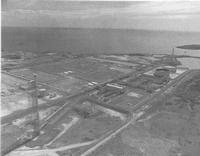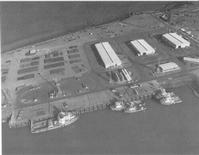


Chapter 6
I Construction During The Settlement Years
II The Use Of Timber As A Structural Material
III Structural Steel
IV Concrete Technology
V Housing
VI Industrialised Pre-cast Concrete Housing
VII Ports And Harbours
VIII Roads
IX Heavy Foundations
X Bridges
XI Sewerage
XII Water Engineering
XIII Railways
XIV Major Buildings
XV Airports
XVI Thermal Power Stations
XVII Materials Handling
XVIII Oil Industry
XIX The Snowy Mountains Scheme
XX The Sydney Opera House
XXI The Sydney Harbour Bridge
XXII Hamersley Iron
XXIII North West Shelf
Sources and References
Index
Search
Help
Contact us

Comparisons with the Snowy Mountains Scheme sit easily with the on-going development of Western Australia's North West Shelf Natural Gas Project.
The construction of the 'Snowy' hydro-electric project extended over two and a half decades and it is estimated that in mid-1980s dollars (when the project based on the vast reserves of natural gas below the waters of Australia's north west continental shelf really hit its straps) it would have cost about $5 billion.
The first phase of the North West Shelf Project -the provision of gas for Western Australian homes and industry -came on stream in 1984 at a cost of $2.2 billion and 20 years after petroleum exploration first started off the WA coast.
But the comparison really applies to the Liquefied Natural Gas (LNG) Phase begun in August, 1985 at an estimated construction cost through to the year 2000 of $9.8 billion in 1985 dollars. This phase will see a plateau level of six million tonnes a year of LNG being shipped from the North West Shelf to eight of Japan's major gas and electricity utilities with deliveries beginning in October, 1989.
From an engineering viewpoint, men, money and machinery have since 1980 been mobilised on an unprecedented scale, both 130 kilometres offshore from the port of Dampier, where the world's largest gas production platform (in terms of production capacity) has been established, and onshore 1,200 kilometres north of Perth, where the hard-won gas is processed at a state-of-the-art treatment plant built among the red rocks and sun-bleached terrain of the Pilbara.
As befitting the largest natural resource development yet undertaken in Australia, tapping of what has been dubbed 'the loneliest gas in the world' has been and still is a mighty engineering and construction achievement.
The billions of cubic metres of gas in the North Rankin and nearby fields out from Dampier are trapped in layers of porous sandstone more than three kilometres below the sea floor, which itself is 125 metres from the surface.
The Joint Venture Participants in 1980-Woodside Petroleum, BP, Shell, BHP, and the Chevron Group -were faced with all the usual problems associated with a project of such magnitude and additional worries such as seasonal cyclones and infrastructure development in a region as inhospitable as the Pilbara.
Nevertheless, it was only four short years from when the Participants pushed the 'go' button in 1980 to when the first natural gas was flowing through the State Energy Commission of Western Australia's 1,500 kilometre pipeline and into the industries and homes of the Commission's customers in the far more populous south of the State.
In that time the Operator, Woodside Offshore Petroleum, built: the North Rankin A platform, a 50,000 tonne, 214 metre high steel structure standing in 125 metres of water and designed to withstand the severe cyclone conditions (Fig. 83); a 1016 mm undersea pipeline, 134 kilometres long to carry gas and condensate (similar to a light crude oil) from the platform to the shore; a gas treatment plant on the Pilbara's Burrup Peninsula; and support facilities including an onshore supply base to service offshore operations; communications facilities including a helicopter base, and housing in the nearby town of Karratha (Figs. 84 and 85).



Organisations in Australian Science at Work - B.P. Australia; Shell Co. of Australia; State Energy Commission of W.A.; Woodside Offshore Petroleum; Woodside Petroleum Limited
People in Bright Sparcs - Tapper, P. P.
 |
Australian Academy of Technological Sciences and Engineering |  |
© 1988 Print Edition pages 430 - 432, Online Edition 2000
Published by Australian Science and Technology Heritage Centre, using the Web Academic Resource Publisher
http://www.austehc.unimelb.edu.au/tia/430.html